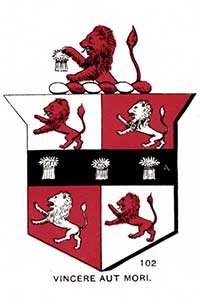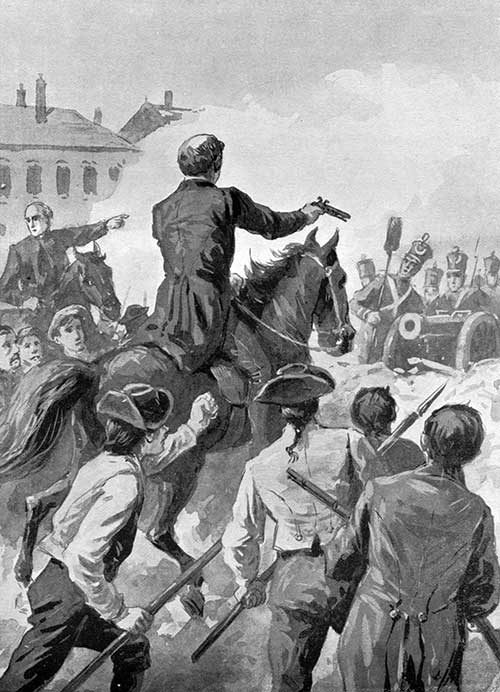The Murphy Family

(Crest No. 102. Plate 27.)
THIS family is descended from Milesius, King of Spain, through the line of his son Heremon, and belonged to the Hy Fiacha tribe. The founders of the family were Fiacha Baiceada, son of Cathire More, King of Ireland. A. D. 144, and Feidlim, son of Eana Kinsealach, King of Leinster. The ancient name was Murchuda, signifying “Superior.”
The Murphys took their name from Feidhlim, younger son of Enna Kinsellegh, King of Leinster.
The chiefs of the sept were styled Lords of Hy Reling, and their possessions were located in the present Counties of Wexford and Cork.
The territory of the Murphys comprised the Murroos, or barony of Ballaghkeen, in the County of Wexford, and the family seat was in the locality now known as Castle Ellis. A considerable branch of the family retained possession of their estate at Oulartleigh till within the present century.
During the Williamite wars in Ireland the Murphys were conspicuous for their support of King James the Second, and they contributed many officers to Hamilton’s, Kenmare’s, Tyrone’s , Bellew’s, Kilmallock’s and Hudson’s infantry regiments. After the defeat of James seven members of the Murphy sept were dispossessed of their estates in Wexford, besides many more in other counties.
During the existence of the Irish Brigade in France, from 1691 until the period of the French Revolution, there were several of the name in the list of officers from the rank of Lieutenant to that of Major in the regiments of Charlemont, Clancarty, Limerick, Fitzgerald, Galmoy, Dillon and Clare, and also in many French regiments. One of these, Lieutenant-Colonel Murphy of Lally’s Regiment, signalized himself under that officer in his campaign against the English in India.
Two priests of this name, Father John and Father Michael Murphy, bore a prominent part in the Irish Rebellion of 1798. Father John Murphy placed himself at the head of his people, and having collected a considerable force, met the English troops in several fierce contests, in which he showed as much skill as courage, notably at Oulart Hill, where he defeated the Royalists. He was finally captured, and after being brutally scourged and maltreated, was put to death as a “rebel.”
Rev. Michael Murphy was killed by a cannon ball while leading a charge within thirty yards of the enemy’s lines at the battle of Arklow. After his chapel had been wrecked and burned by the yeomanry, he joined Father John Murphy’s brigade. His heroic death is thus related by the English historian Froude: “The battery behind the barricade completely swept the road. Twice the priests led on their followers over the bodies of their fallen comrades, through the musket shot and round shot and grape, to the very mouths of the guns, the priests coming so close that they shot the gunners at their posts with their pistols. Twice they failed; the second time with such desperate loss that they wavered and sought shelter among the walls. A third time they charged till they again touched the barricade. With a contempt of death which was really admirable they seemed determined to take the guns, though every man might fall in doing it, when a round shot caught him [Father Michael Murphy] and his horse, and hurled them into ruin.” The British soldiers cut open this patriot priest’s dead body, took out the heart, roasted the body, and oiled their boots with the grease that dripped from it.

REV. MICHAEL MURPHY
At the Battle of Arklow.
Arthur Murphy, an eminent actor and dramatic author, was born in the County of Roscommon in 1730. He was educated in France under an assumed name, according to the custom of the time, in order to escape the penalties of the “law” for being educated abroad, while it was a felony to be educated at home. Murphy was admitted to the Bar in London, but soon turned his attention to dramatic writing, in which he was eminently successful. “Murphy,” says Macaulay, “was supposed to understand the temper of the wit of his time as well as any man.” Many of his plays retain their hold on the stage at the present day.
James Cavanagh Murphy, traveler, author and architectural artist, died in 1816. He was the author of many works of merit. Of his “Arabian Antiquities of Spain” Allibone says: “It would be difficult to say too much in commendation of it.” John Murphy, the Gaelic poet, was a native of the County of Cork, and was born in 1700. His elegaic compositions in Irish are pronounced by competent critics to be extremely beautiful. He presided as patron for many years at an annual bardic session held in Charleville, County Cork.
Robert Murphy, one of the most remarkable mathematicians of his time, was also a native of the County of Cork, where he was born in l806. He was the son of a poor shoemaker, and having developed a marvelous aptitude for mathematics before he entered his “teens,” he was sent to school by some admirors of his genius, and afterward entered at Caius College, Cambridge University, England, where he was in a few years elected a Fellow, and appointed Dean of his college. He was also appointed Examiner in Mathematics at University College, London. He fell into irregular habits, and died in his thirty-seventh year. He left several excellent works, mostly on scientific and mathematical subjects.
The Murphy family, according to the last Irish census, is the most numerous of any in Ireland. The name is found in nearly every locality in the island, and both at home and abroad a Murphy is supposed to be a typical Irishman. Formerly an O was prefixed to the name, but it has long been discarded. The Irish antiquary, Dr. O’Donovan, writing in 1861, says: “Don Patricio O’Murphy, the steward of the Duke of Wellington’s estate in Spain, is the only man living who retains the O in this name.”
The name is relatively as numerous in the United States and the British Colonies as it is in its original home. Of the many distinguished men of the name in the United States the late Henry Murphy of Brooklyn, N. Y., formerly United States Minister at The Hague, is worthy of special mention. He was one of the most public spirited citizens in the State of New York, and accomplished more for the development of the City of Brooklyn than, perhaps, any other of its citizens. He was the first to advocate the construction of a bridge connecting that city with New York, and the magnificent structure that now unites the two sections of the “Greater New York” may be said to be largely the fruit of his work.
Mr. Thomas C. Murphy, late Collector of the Port of New York, has been for many years one of the most esteemed and enterprising citizens of the metropolis. Another worthy descendant of this family was the late Hon. Jeremiah Murphy, formerly member of Congress from Iowa, and Mayor of the City of Davenport in that State. Mr. Murphy was one of the earliest and most earnest advocates of the Hennepin Canal scheme, which had been before Congress for more than a quarter of a century. He lived to see the enterprise commenced, which is destined, through the connection of Chicago with the Mississippi River by water, to add enormously to the development of all that section of the West.
Colonel Charles J. Murphy of Brooklyn, N. Y., served with distinction in the Mexican War and the war for the Union, receiving distinguished honors for his bravery and humanity.
